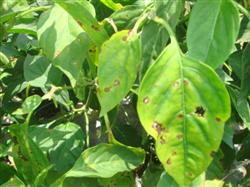What causes pepper anthracnose?

What causes pepper anthracnose? Please introduce in detail the anthracnose of pepper, also known as pepper continuous cropping disease, is the main disease of pepper, the distribution is widespread and serious. Under the condition of high temperature and high humidity, the epidemic spreads quickly, the damage time is long, the damage is serious and the loss is great. Pepper anthracnose can occur from seedbed to transplanting, which mainly harms leaves and fruits, especially mature fruits and old leaves. The leaf is damaged, the edge of the leaf is water-stained brown spots, nearly round and light gray in the middle, on which there are whorled black spots, that is, the conidium disk of the pathogen. The fruit pedicel is damaged, resulting in brown irregular sunken spots, which are easy to crack when dry. In the mature stage, the disease resistance of the plant is poor, under the condition of heavy rain or high temperature, the fruit is vulnerable, the disease spot is brown, and the water-stained circle forms an irregular disease spot, on which there are many black dots and a moist discoloration ring. After the fruit is injured, it is easy to dry and shrink, and the disease spot is membrane-like, like velvet and easy to break. The cause of anthracnose of pepper is that the disease resistance of pepper is worse than that of sweet chili. In recent years, the wet hybrid and degradation of varieties is also an important reason for the prevalence of the disease. Continuous cropping planting for years, the pathogen accumulation is fast, the base is high, once the conditions are suitable, the disease will rapidly expand and spread. The removal of diseased leaves, diseased fruits and residues is not complete, and the bacteria continue to spread outward through wind and rain. Even if the new stubble is new, as long as the pathogen exists and the conditions are suitable, it can cause disease outbreak and epidemic. The management of seedling bed is unscientific, that is, it does not carry out seed chemical sterilization and soil disinfection. Under the condition of high temperature and high humidity, seedling bed infection can continue to harm after moving into the field. Germs invade from the wound and spread through wind and rain, air currents, aphids, hopping cicadas and other stinging pests. The developmental temperature of the pathogen is 12 ℃ 32 ℃, the optimum temperature is 27 Mir, and the relative humidity is about 95%. The rainy season comes early and the temperature and humidity are suitable, which is also an important reason for the occurrence and epidemic of the disease. There are many times of repeated infection, under suitable temperature conditions, the relative humidity is 87% Mak 95%, the incubation period of bacteria is only about 3 days, the number of infections is frequent, and the pathogen accumulates quickly, which can cause a pandemic in a short time. Drought, continuous high temperature and severe sunburn in summer are beneficial to the prevalence of diseases in the later stage. High planting density, partial application of nitrogen fertilizer, poor drainage, poor ventilation and light transmission can accelerate the epidemic of the disease. The medicine did not ignore the seedbed and field chemical control in time, and did not do early detection and early treatment, prevention and cure in the end. Click to get more chili planting techniques click to get more vegetable planting techniques
- Prev

What is pepper anthracnose?
What is pepper anthracnose? What method can be prevented and treated for pepper anthracnose? Please help to introduce that anthracnose is the main disease of hot pepper, which spreads quickly under the condition of high temperature and humidity, harms for a long time, and often causes great losses. Anthracnose can occur in pepper during the whole growth period. Anthracnose mainly harms leaves and fruits.
- Next

What harm does pepper anthracnose have?
What harm does pepper anthracnose have? How to prevent and cure anthracnose of pepper? Also ask netizens to help introduce the harm and control methods of pepper anthracnose, the following farming network sorted out for your reference. The harm of pepper anthracnose: black anthracnose mostly occurs on pepper fruits and leaves, especially mature fruits and.
Related
- Where is it suitable to grow horseradish in China? it is expected to see the middle altitude horseradish in Alishan.
- How to prevent tomato virus disease reasonably? (Control methods included)
- Many people like to plant towel gourd on the balcony. What are the main points of this method and management?
- What crops can chili peppers be mixed with?
- Fertilization techniques and matters needing attention in Tomato
- What are the grafting techniques for peach seedlings in spring?
- Harm and control methods of root swelling disease of Chinese cabbage
- What are the pests of sweet potatoes? How to prevent and cure it?
- Symptoms, causes and Control methods of navel Rot in Tomato
- The cause of "Cucumber rotten bibcock" in Farmers' planting Cucumber and its Control Plan

